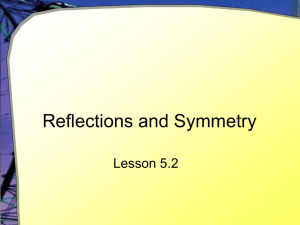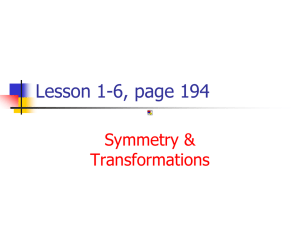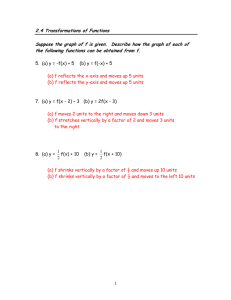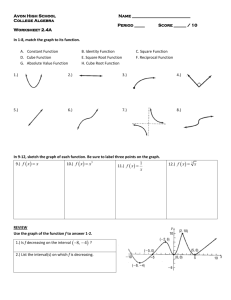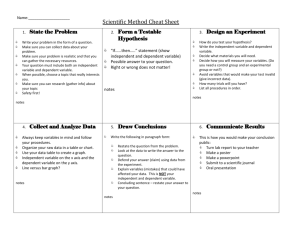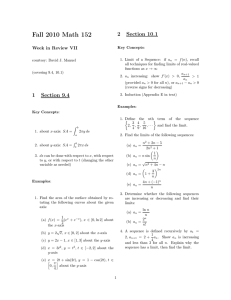Graphing Techniques: Stretching, Symmetry, & Translations
advertisement
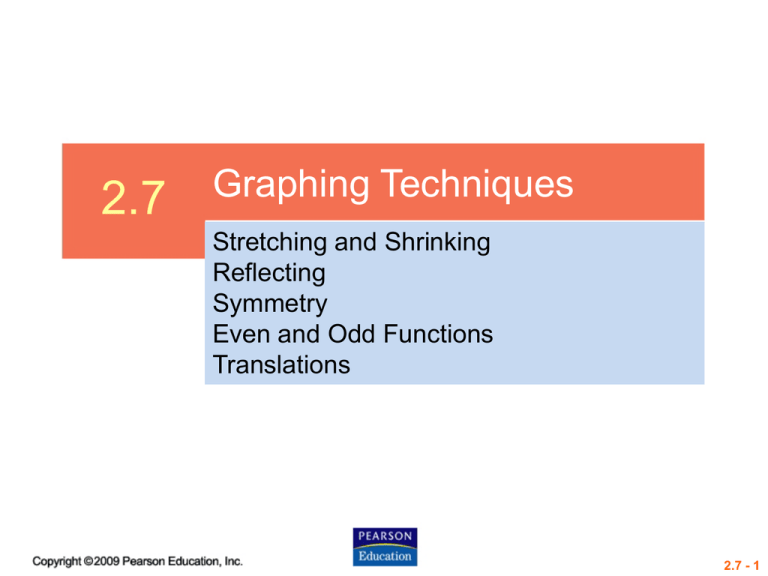
2.7 Graphing Techniques Stretching and Shrinking Reflecting Symmetry Even and Odd Functions Translations 2.7 - 1 Example 1 STRETCHING OR SHRINKING A GRAPH Graph the function a. g ( x ) = 2 x Solution Comparing the table of values for ƒ(x) = |x| and g(x) = 2|x|, we see that for corresponding xvalues, the y-values of g are each twice those of ƒ. So the graph of g(x) is narrower than that of ƒ(x). x –2 –1 0 1 2 ƒ(x) g(x) |x| 2|x| 2 4 1 2 0 0 1 2 2 4 2.7 - 2 STRETCHING OR SHRINKING A GRAPH Example 1 Graph the function a. g ( x ) = 2 x y x 4 3 –4 –3 –2 x 1 –2 –3 2 3 4 –2 –1 0 1 2 ƒ(x) g(x) |x| 2|x| 2 4 1 2 0 0 1 2 2 4 –4 2.7 - 3 Example 1 STRETCHING OR SHRINKING A GRAPH 1 b. h( x ) = x 2 Solution The graph of h(x) is also the same general shape as that of ƒ(x), but here the coefficient ½ causes the graph of h(x) to be wider than the graph of ƒ(x), as we see by comparing the tables of values. x ƒ(x) x h(x) 1 2 x –2 –1 0 1 2 2 1 0 1 2 1 ½ 0 ½ 1 2.7 - 4 STRETCHING OR SHRINKING A GRAPH Example 1 1 b. h( x ) = x 2 y 4 3 –4 –3 –2 x 1 –2 2 3 4 x ƒ(x) x h(x) 1 2 x –2 –1 0 1 2 2 1 0 1 2 1 ½ 0 ½ 1 –3 –4 2.7 - 5 Example 1 STRETCHING OR SHRINKING A GRAPH c. k ( x ) = 2 x Solution Use Property 2 of absolute value ( ab = a b ) to rewrite 2 x . k (= x ) 2= x 2 = x 2x Property 2 The graph of k(x) = 2 is the same as the graph of k(x) = 2xin part a. 2.7 - 6 Vertical Stretching or Shrinking of the Graph of a Function Suppose that a > 0. If a point (x, y) lies on the graph of y = ƒ(x), then the point (x, ay) lies on the graph of y = aƒ(x). a. If a > 1, then the graph of y = aƒ(x) is a vertical stretching of the graph of y = ƒ(x). b. If 0 < a <1, then the graph of y = aƒ(x) is a vertical shrinking of the graph of y = ƒ(x) 2.7 - 7 Reflecting Forming a mirror image of a graph across a line is called reflecting the graph across the line. 2.7 - 8 Example 2 REFLECTING A GRAPH ACROSS AN AXIS Graph the function. a. g ( x ) = − x Solution Every yvalue of the graph is the negative of the corresponding y-value of ƒ( x ) = x. x 0 1 4 ƒ(x) x 0 1 2 g(x) − x 0 –1 –2 2.7 - 9 Example 2 REFLECTING A GRAPH ACROSS AN AXIS Graph the function. a. g ( x ) = − x y 4 x 0 1 4 ƒ(x) x 0 1 2 g(x) − x 0 –1 –2 3 2 –4 –3 –2 1 x 2 3 4 –2 –3 –4 2.7 - 10 Example 2 REFLECTING A GRAPH ACROSS AN AXIS Graph the function. b. h( x )= − x Solution If we choose x-values for h(x) that are the negatives of those we use for ƒ(x), the corresponding yvalues are the same. The graph h is a reflection of the graph ƒ across the y-axis. x –4 –1 0 1 4 h(x) ƒ(x) x −x undefined 2 undefined 1 0 0 1 undefined 2 undefined 2.7 - 11 REFLECTING A GRAPH ACROSS AN AXIS Example 2 Graph the function. b. h( x )= − x y x 4 3 –4 –3 –2 1 –2 2 3 4 –4 –1 0 x 1 4 h(x) ƒ(x) x −x undefined 2 undefined 1 0 0 1 undefined 2 undefined –3 –4 2.7 - 12 Reflecting Across an Axis The graph of y = –ƒ(x) is the same as the graph of y = ƒ(x) reflected across the x-axis. (If a point (x, y) lies on the graph of y = ƒ(x), then (x, – y) lies on this reflection. The graph of y = ƒ(– x) is the same as the graph of y = ƒ(x) reflected across the y-axis. (If a point (x, y) lies on the graph of y = ƒ(x), then (– x, y) lies on this reflection.) 2.7 - 13 Symmetry with Respect to An Axis The graph of an equation is symmetric with respect to the y-axis if the replacement of x with –x results in an equivalent equation. The graph of an equation is symmetric with respect to the x-axis if the replacement of y with –y results in an equivalent equation. 2.7 - 14 Example 3 TESTING FOR SYMMETRY WITH RESPECT TO AN AXIS Test for symmetry with respect to the x-axis and the y-axis. y x2 + 4 a. = Solution Replace x with –x. y = y x +4 2 y = ( −x ) + 4 4 2 = y x +4 2 Equivalent –2 x 2 2.7 - 15 TESTING FOR SYMMETRY WITH RESPECT TO AN AXIS Example 3 Test for symmetry with respect to the x-axis and the y-axis. y x2 + 4 a. = Solution The result is the same as the original equation and the graph is symmetric with respect to the y-axis. 2 = y x +4 y = ( −x ) + 4 2 Equivalent = y x +4 2 2.7 - 16 TESTING FOR SYMMETRY WITH RESPECT TO AN AXIS Example 3 Test for symmetry with respect to the x-axis and the y-axis. b. = x y2 − 3 Solution Replace y with –y. = x y −3 2 x = ( −y ) − 3 2 Equivalent = y −3 2 2.7 - 17 Example 3 TESTING FOR SYMMETRY WITH RESPECT TO AN AXIS Test for symmetry with respect to the x-axis y and the y-axis. b. = x y2 − 3 Solution The graph is symmetric with respect to the x-axis. 2 = x y −3 –2 x = ( −y ) − 3 2 Equivalent 4 x 2 = y −3 2 2.7 - 18 Example 3 TESTING FOR SYMMETRY WITH RESPECT TO AN AXIS Test for symmetry with respect to the x-axis and the y-axis. c. x 2 + y 2 = 16 Solution Substituting –x for x and –y in for y, we get (–x)2 + y2 = 16 and x2 + (–y)2 = 16. Both simplify to x2 + y2 = 16. The graph, a circle of radius 4 centered at the origin, is symmetric with respect to both axes. 2.7 - 19 Example 3 TESTING FOR SYMMETRY WITH RESPECT TO AN AXIS Test for symmetry with respect to the x-axis and the y-axis. 4 d. 2 x + y = Solution In 2x + y = 4, replace x with –x to get –2x + y = 4. Replace y with –y to get 2x –y = 4. Neither case produces an equivalent equation, so this graph is not symmetric with respect to either axis. 2.7 - 20 Symmetry with Respect to the Origin The graph of an equation is symmetric with respect to the origin if the replacement of both x with –x and y with –y results in an equivalent equation. 2.7 - 21 Example 4 TESTING FOR SYMMETRY WITH RESPECT TO THE ORIGIN Is this graph symmetric with respect to the origin? a. x 2 + y 2 = 16 Solution Replace x with –x and y with –y. 2 2 x +y = 16 Use parentheses around – x and – y ( − x ) + ( − y ) = 16 2 2 Equivalent x +y = 16 The graph is symmetric with respect to the origin. 2 2 2.7 - 22 Example 4 TESTING FOR SYMMETRY WITH RESPECT TO THE ORIGIN Is this graph symmetric with respect to the origin? b. y = x 3 Solution Replace x with –x and y with –y. y=x The graph is symmetric with respect to the origin. 3 −y = ( − x ) − y =− x 3 3 Equivalent y = x3 2.7 - 23 Symmetry with Respect to: Equation is unchanged if: x-axis y-axis Origin y is replaced with –y x is replaced with –x x is replaced with –x and y is replaced with – y y Example 0 y y x 0 x 0 x 2.7 - 24 Even and Odd Functions A function ƒ is called an even function if ƒ(–x) = ƒ(x) for all x in the domain of ƒ. (Its graph is symmetric with respect to the y-axis.) A function ƒ is called an odd function is ƒ(–x) = –ƒ(x) for all x in the domain of ƒ. (Its graph is symmetric with respect to the origin.) 2.7 - 25 Example 5 DETERMINING WHETHER FUNCTIONS ARE EVEN, ODD, OR NEITHER Decide whether each function defined is even, odd, or neither. a. ƒ( x ) = 8 x 4 − 3 x 2 Solution Replacing x in ƒ(x) = 8x4 – 3x2 with –x gives: ƒ( − x ) = 8( − x ) − 3( − x ) = 8 x − 3 x = ƒ( x ) 4 2 4 2 Since ƒ(–x) = ƒ(x) for each x in the domain of the function, ƒ is even. 2.7 - 26 Example 5 DETERMINING WHETHER FUNCTIONS ARE EVEN, ODD, OR NEITHER Decide whether each function defined is even, odd, or neither. b. ƒ( x ) = 6 x 3 − 9 x Solution = −= 6 x 3 + 9 x −ƒ( x ) The function ƒ is odd because ƒ(–x) = –ƒ(x). 2.7 - 27 Example 5 DETERMINING WHETHER FUNCTIONS ARE EVEN, ODD, OR NEITHER Decide whether each function defined is even, odd, or neither. c. ƒ( x ) = 3 x 2 + 5 x Solution ƒ( x ) = 3 x 2 + 5 ƒ ( −x = ) 3 ( −x ) + 5 ( −x ) 2 Replace x with –x = 3x − 5x 2 Since ƒ(–x) ≠ ƒ(x) and ƒ(–x) ≠ –ƒ(x), ƒ is neither even nor odd. 2.7 - 28 Example 6 TRANSLATING A GRAPH VERTICALLY Graph g(x) = x– 4 Solution x –4 –1 0 1 4 ƒ(x) x 4 1 0 1 4 y g(x) x −4 0 –3 –4 –3 0 ƒ( x ) = x x –4 4 g ( x= ) x −4 (0, – 4) 2.7 - 29 Vertical Translations 2.7 - 30 TRANSLATING A GRAPH HORIZONTALLY Example 7 Graph g(x) = x – 4 Solution x –2 0 2 4 6 ƒ(x) x 2 0 2 4 6 y g(x) x−4 6 4 2 0 2 ƒ( x ) = x x –4 4 8 g ( x= ) x−4 (0, – 4) 2.7 - 31 Horizontal Translations 2.7 - 32 Horizontal Translations If a function g is defined by g(x)= ƒ(x – c), where c is a real number, then for every point (x, y) on the graph of ƒ, there will be a corresponding point (x + c) on the graph of g. The graph of g will be the same as the graph of ƒ, but translated c units to the right if c is positive or c units to the left if c is negative. The graph is called a horizontal translation of the graph of ƒ. 2.7 - 33 Example 8 USING MORE THAN ONE TRNASFORMATION ON GRAPHS Graph the function. a. ƒ( x ) = − x + 3 +1 Solution To graph this, the lowest point on the graph of y = xis translated 3 units to the left and up one unit. The graph opens down because of the negative sign in front of the absolute value expression, making the lowest point now the highest point on the graph. The graph is symmetric with respect to the line x = –3. 2.7 - 34 Example 8 USING MORE THAN ONE TRNASFORMATION ON GRAPHS Graph the function. a. ƒ( x ) = − x + 3 +1 y ƒ( x ) = − x + 3 +1 3 x –6 –3 –2 2.7 - 35 Example 8 USING MORE THAN ONE TRNASFORMATION ON GRAPHS Graph the function. b. h( = x ) 2x − 4 Solution To determine the horizontal translation, factor out 2. h( = x ) 2x − 4 = 2 ( x − 2) = 2 x − 2 = 2 x −2 Factor out 2. ab = a b 2 =2 2.7 - 36 Example 8 USING MORE THAN ONE TRNASFORMATION ON GRAPHS Graph the function. h( x ) = 2 x − 4 = 2 x − 2 b. h( x ) = − 2x − 4 y Solution Factor out 2. 4 y= x 2 x 2 4 2.7 - 37 Example 8 USING MORE THAN ONE TRNASFORMATION ON GRAPHS Graph the function. 1 2 c. g ( x ) = − x +4 2 Solution It will have the same shape as that of y = x2, but is wider (that is, shrunken vertically) and reflected across the x-axis because of the negative coefficient and then translated 4 units up. 2.7 - 38 Example 8 USING MORE THAN ONE TRNASFORMATION ON GRAPHS Graph the function. 1 2 c. g ( x ) = − x +4 2 y Solution 4 x –3 3 –3 2.7 - 39 Summary of Graphing Techniques In the descriptions that follow, assume that a > 0, h > 0, and k > 0. In comparison with the graph of y = ƒ(x): 1. The graph of y = ƒ(x) + k is translated k units up. 2. The graph of y = ƒ(x) – k is translated k units down. 3. The graph of y = ƒ(x + h) is translated h units to the left. 4. The graph of y = ƒ(x – h) is translated h units to the right. 5. The graph of y = aƒ(x) is a vertical stretching of the graph of y = ƒ(x) if a > 1. It is a vertical shrinking if 0 < a < 1. 6. The graph of y = aƒ(x) is a horizontal stretching of the graph of y = ƒ(x) if 0 < a < 1. It is a horizontal shrinking if a > 1. 7. The graph of y = – ƒ(x) is reflected across the x-axis. 8. The graph of y = ƒ(– x) is reflected across the y-axis. 2.7 - 40
